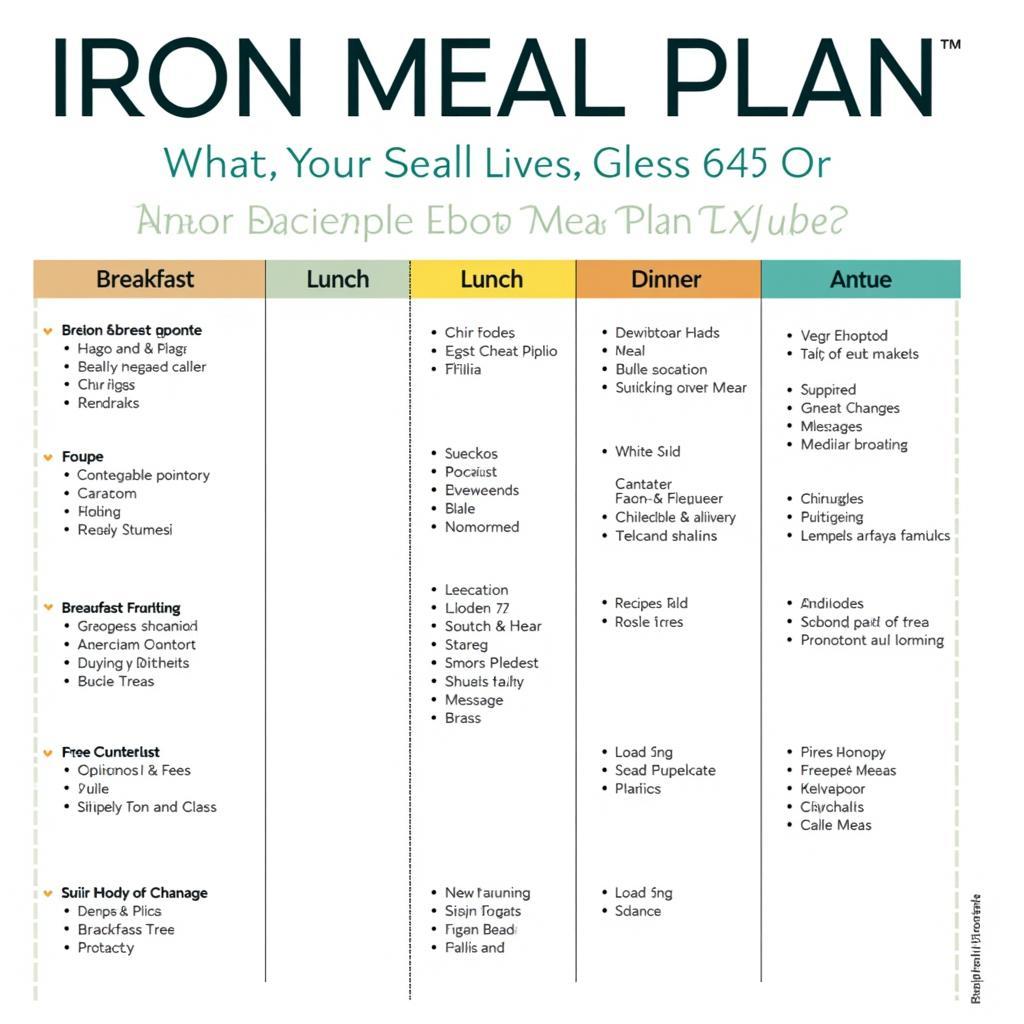Ferro food refers to foods that are rich in iron. Iron is an essential mineral crucial for various bodily functions, particularly for producing hemoglobin, the protein in red blood cells that carries oxygen throughout the body. Understanding what ferro food is and incorporating it into your diet is key for maintaining good health and preventing iron deficiency. Let’s dive deeper into the world of iron-rich foods.
Why is Ferro Food Important?
Iron plays a vital role in several crucial bodily functions, including energy production, oxygen transport, and immune system function. Without adequate iron, your body struggles to produce enough healthy red blood cells, leading to iron deficiency anemia. This condition can cause fatigue, weakness, shortness of breath, and pale skin. Consuming a diet rich in ferro food can help prevent these issues and ensure optimal health.
Recognizing Iron Deficiency
Understanding the signs of iron deficiency can be the first step in addressing the problem. Symptoms can range from mild to severe and often include persistent fatigue, dizziness, headaches, brittle nails, and unusual cravings for non-nutritive substances like ice or dirt (a condition known as pica). If you experience any of these symptoms, consult a healthcare professional for proper diagnosis and advice on incorporating more ferro food into your diet.
Many everyday foods are excellent sources of iron. Red meat, particularly beef and lamb, are well-known for their high iron content. Organ meats, such as liver, are also exceptionally rich in iron. Poultry and fish, although containing less iron than red meat, still contribute to your daily intake. For vegetarians and vegans, plant-based sources of iron include legumes, such as lentils and beans, dark leafy greens like spinach and kale, and fortified cereals.
Boosting Iron Absorption
While consuming ferro food is essential, maximizing iron absorption is equally important. Certain factors can enhance or inhibit iron absorption. Vitamin C, for instance, significantly improves the body’s ability to absorb iron from plant-based sources. Pairing iron-rich foods with vitamin C-rich foods like citrus fruits or bell peppers can optimize your iron intake. Conversely, consuming calcium-rich foods or drinks alongside iron-rich meals can hinder iron absorption.
Tips for Maximizing Iron Intake
Here are some practical tips to help you maximize your iron intake:
- Combine iron-rich foods with vitamin C-rich foods.
- Cook with cast iron cookware.
- Avoid drinking tea or coffee with meals.
- Consume iron supplements only if recommended by a healthcare professional.
“Understanding how your body absorbs iron is just as crucial as knowing which foods contain it,” says renowned nutritionist Dr. Amelia Carter. “Combining iron-rich foods with vitamin C-rich foods can significantly enhance absorption, making every bite count.”
The Importance of a Balanced Diet
While focusing on ferro food is important, it’s crucial to remember that a balanced diet is key to overall health. Including a variety of nutrient-rich foods from all food groups ensures your body receives all the essential vitamins, minerals, and macronutrients it needs to thrive. Don’t fixate solely on iron; embrace a holistic approach to nutrition.
Planning Iron-Rich Meals
Planning your meals can be a great way to ensure you’re getting enough iron. Incorporate iron-rich foods into your breakfast, lunch, and dinner. Try a spinach and feta omelet for breakfast, lentil soup for lunch, and a lean beef stir-fry for dinner. Get creative with your meal planning and explore new recipes to keep your meals interesting and enjoyable.
“A healthy diet doesn’t have to be complicated,” says culinary expert Chef Michael Rossi. “Simple meal planning with a focus on whole foods, including plenty of ferro food, can make a world of difference in your overall health and well-being.”
 Iron-Rich Meal Plan
Iron-Rich Meal Plan
In conclusion, understanding what ferro food is and incorporating it into your diet is crucial for maintaining optimal health. By focusing on iron-rich foods and employing strategies to maximize iron absorption, you can prevent iron deficiency and enjoy its numerous benefits. Remember to maintain a balanced diet and consult a healthcare professional if you suspect you have an iron deficiency.
FAQ
- What are the best sources of ferro food? Red meat, organ meats, poultry, fish, legumes, leafy greens, and fortified cereals are excellent sources.
- How can I increase my iron absorption? Combine iron-rich foods with vitamin C-rich foods, cook with cast iron cookware, and avoid tea/coffee with meals.
- What are the symptoms of iron deficiency? Fatigue, weakness, shortness of breath, pale skin, dizziness, headaches, brittle nails, and pica.
- Who is at risk for iron deficiency? Pregnant women, infants, young children, vegetarians, vegans, and individuals with certain medical conditions.
- Should I take iron supplements? Consult a healthcare professional before taking iron supplements.
- How much iron do I need daily? The recommended daily intake varies based on age, gender, and health status. Consult a healthcare professional for personalized advice.
- Can I get too much iron? Yes, excessive iron intake can be harmful. Consult a healthcare professional for guidance.
Check out our article on survival gear and food for tips on incorporating iron-rich foods into your emergency preparedness plan.
Need more information? Explore our other articles related to nutrition and healthy eating.
If you have questions or concerns about incorporating ferro food into your diet, please don’t hesitate to contact us. Call us at 02437655121, email us at [email protected], or visit us at 3PGH+8R9, ĐT70A, thôn Trung, Bắc Từ Liêm, Hà Nội, Việt Nam. Our customer service team is available 24/7 to assist you.